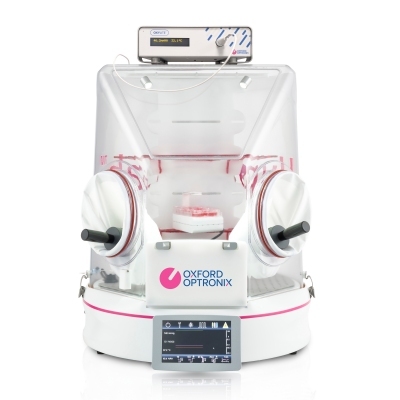Introduction
Experimental reproducibility is critical in scientific research because it allows other scientists to verify the results and conclusions of a study. When a study can be reproduced using the same methods, materials, and conditions, it increases confidence in the findings and strengthens the scientific knowledge base.
This holds true for the microenvironment generated in modern hypoxia / physoxia workstations that are used to maintenance cells in vitro under conditions that imitate the natural in vivo oxygen state.
Yet the vast majority of hypoxic / physoxic workstations in use today are controlled using a proportional measurement of oxygen (percent oxygen), leading to variability in the actual oxygen concentration experienced by cells due to varying atmospheric pressure caused by weather patters and by laboratory altitude, i.e., geographical location.
Why rock the boat
Commercial oxygen sensors can be traced back to the late 70s and their application in the automobile industry. These zirconia-based designs were later adapted for in tri-gas incubators capable of controlling oxygen levels during cell culture. Zirconia-based oxygen sensors measure the proportion of oxygen in the gas being analysed, where oxygen is expressed in units of percent.
Little has changed in the world of controlled oxygen incubators, with oxygen being measured and maintained using the same proportional (percent) oxygen measurement approach in almost all commercially available systems today.
This is problematic since a percent oxygen measurement does not account for variability in atmospheric pressure.
The oxygen partial pressure advantage
Roughly one fifth of earths atmosphere consists of oxygen. As the density of the atmosphere, i.e., the barometric pressure, decreases with altitude above sea level or fluctuates due to weather patterns, so does the availability of oxygen. However, it always remains a fixed proportion.
In cell culture, controlling chamber oxygen using percent oxygen does not account for these barometric pressure changes.
In numbers, a scientist at sea level setting up a hypoxia incubator at 5% oxygen may unwittingly be exposing their cultures to true oxygen concentrations varying by up to 0.5% from that set point over the course of an incubation, purely due to weather patterns.
Similarly, a scientist setting up a hypoxia incubator at 5% oxygen in Denver, Colorado (altitude 1,600 m) is exposing cells to approximately 15% less oxygen than a laboratory doing likewise at sea level.
Crucially, both of the above limitations can be resolved by measuring and controlling oxygen directly using a direct partial pressure of oxygen measurement, expressed in units of mmHg or kPa. As this approach directly measures the concentration of oxygen rather than the proportion of oxygen in the gas phase, it intrinsically ‘compensates’ for barometric pressure variability, be it due to dynamic weather patterns or laboratory altitude above sea level.
In other words, a scientist using a hypoxia incubator controlled using the oxygen partial pressure approach can trust that a setting of 38 mmHg oxygen (the equivalent of 5% oxygen at sea level and at mean atmospheric pressure) really does mean 38 mmHg, independent of weather and independent of laboratory altitude.
This approach therefore has the potential to address a fundamental shortcoming that currently afflicts almost all hypoxic / physoxic workstations in use today: reproducibility. Unless barometric pressure is accounted for, how can scientific data from existing controlled oxygen incubators and workstations in different laboratories truly be compared?
Why the difference?
There is a surprising disconnect in the scientific literature where in vivo and in vitro studies involving oxygen measurements cite oxygen levels in completely different units.
Oxygen measurements made in vivo are almost always expressed in units of partial pressure (mmHg or kPa). This has scientific merit as it is the partial pressure of oxygen (not merely the proportion of oxygen in the environment) that cells in tissues actually ‘experience’.
Yet, overwhelmingly, in vitro cell biology invariably cites or compares oxygen conditions in proportional units of percent oxygen.
It would seem sensible to eliminate this source of confusion and to consistently express oxygen in its most scientifically rigorous form across all areas of biomedical research, namely in units of partial pressure.
The HypoxyLab™ advantage

The HypoxyLab workstation reproduces physiological conditions by delivering a contamination-free tissue culture environment that offers precise control of oxygen, CO2, temperature, and humidity.
It does so in a remarkably compact and ergonomic form-factor that offers unmatched ease-of-use and economical gas consumption.
Uniquely, the HypoxyLab is the first and only controlled oxygen incubator that measures and controls its oxygen environment using the partial pressure of oxygen (pO2), expressed directly in units of mmHg or kPa.
By correcting for both altitude and atmospheric pressure, scientific data generated from the use of the HypoxyLab in one location or set of atmospheric conditions can be directly compared to scientific data generated (or reproduced) using the HypoxyLab any other geographical location or set of atmospheric conditions.
Resources
McKeown SR (2014).
Defining Normoxia, Physoxia and Hypoxia in Tumours—Implications for Treatment Response. Br J Radiol 87:1035
Keeley TP & Mann GE (2018).
Defining Physiological Normoxia for Improved Translation of Cell Physiology to Animal Models and Humans. Physiological Reviews: 99:1
Download this article
Authors: Michael Rau and Justin Croft, November 2023